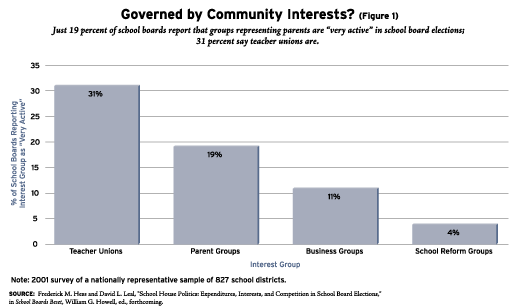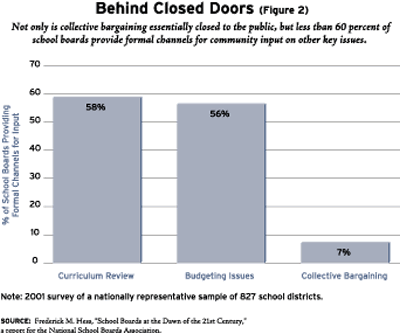
Early 20th century Progressive reformers established elected school boards as a means of shielding public school systems from the politics and patronage of corrupt city governments. Citizens, rather than political dons or their favored appointees, would govern the community’s schools with the community’s interests at heart.
Today, however, elected school boards, especially in America’s troubled cities, are just as apt to contribute to the school system’s ills. They often resemble a dysfunctional family, composed of three unlovable types: 1) aspiring politicians for whom this is a rung on the ladder to higher office; 2) former employees of the school system with a score to settle; and 3) single-minded advocates of one dubious cause or another who yearn to use the public schools to impose their particular hang-up on all the kids in town.
These junior politicians often do more harm than good, representing the community’s factions more than its interests. Progressives thought the elected school board would keep politics out of education. In fact, it has immersed our public schools in politics. One need only witness the behavior of the Chicago and New York City school boards before their recent mayoral takeovers–or the behavior of the Los Angeles and Dallas school boards today.
Cities across America are beginning to recognize that the traditional school board is no longer the embodiment of participatory democracy it was intended to be. The romantic notion that local school boards are elected by local citizens has been replaced with the reality that these elections are essentially rigged. They are held at odd times, when practically nobody votes except those with a special reason to do so. For example, in 2002, just 4 percent of registered voters in Dallas turned out to participate in July elections that replaced six school board members. And, of course, those motivated voters include a disproportionate number of the school system’s own employees.
The teacher unions now dominate many a school board election, or at least have the capacity to do so (see Figure 1). When the board is quiet and rocks no education boats, the union rests. But as we have seen in cities like Milwaukee and Los Angeles, when the board undertakes the kinds of reforms that the union doesn’t favor, the union will mobilize to elect friendly candidates. Thus, in 2002, the Los Angeles union unseated a majority of the reform-minded board that had selected former Colorado governor Roy Romer to lead the city’s troubled school system. Likewise, in 1995, a union-led coup in Milwaukee produced a majority on that city’s school board that reform superintendent Howard Fuller realized he could not work with.

Is it any wonder, then, that cities like New York, Chicago, and Boston have torn down the Chinese wall that was supposed to isolate school districts from city governments and placed responsibility for the schools squarely in the hands of the mayor? In these cities, there is now a single, publicly accountable official in charge, rather than nine wannabe mayors immobilizing the school system with their petty squabbles, power grabs, and turf protecting. If citizens are unhappy with the schools, they can now vote the mayor out of office. This does not eliminate democratic control over the schools; it rechannels–and strengthens–it.
Perpetuating Inequity
Local school boards exist largely to oversee the spending of funds drawn from local property taxes. In this sense, they are supposed to be the community’s accountability mechanism, ensuring that school officials use locally generated resources wisely and responsibly. However, several trends are rendering that role obsolete.
First, there is an increasing recognition that the funding system that school boards perpetuate results in unfair resource disparities between wealthy and poor school districts. It discourages the best teachers from entering the schools where they’re needed most and further segregates families by income and race. The wave of lawsuits involving school finances that have been filed against the states has resulted in states (and, indirectly, Washington) taking ever-greater responsibility for funding local public schools. In the past 50 years, the share of school spending provided by states increased from 40 percent to 50 percent, while the share provided by localities decreased from 57 percent to 43 percent. This trend will only continue.
Second, the standards and accountability movement is rendering the performance of individual schools transparent to parents and communities. Under yesterday’s system, school boards were needed to keep watch over the superintendent, assistant superintendents, and other district officials as they managed the school system. Now, however, parents can use the information gleaned from state accountability systems to assess the performance of an individual school or school system.
Third, the choice movement, including charter schools, magnet schools, vouchers, and outsourced school management, has shown us what it means to devolve authority from bureaucratic systems to individual schools and families. Power is flowing downward, to the principal, to the teaching team, and to parents themselves. Once every school is essentially a charter school, there will be no need for a centralized municipal-level body that makes decisions for an entire school system. Individual schools will respond to the needs of their families and employees while the state sets standards and monitors academic results.

School boards are supposed to provide top-down accountability. But these three trends–the steady centralization of funding, the imposition of statewide accountability systems, and the expansion of choice–are creating a system that favors bottom-up accountability and obviates the need for local boards.
Ultimately, the only way to guarantee that every child receives equal support will be for states to take responsibility for funding the schools, with help from the feds. A statewide taxation and funding system would provide a certain amount of tuition dollars to each child with the amounts varying according to individual needs. For example, disabled or severely disadvantaged children would receive more. Then the money follows the child, in a virtual “financial backpack,” to the school of the family’s choice. Once the state issues its annual report on schools’ academic progress, safety, and teachers’ qualifications, families can decide where to send their children and tuition dollars.
With this kind of information and consumer power, there is no need for a locally elected board to advocate for better curriculum or more money at the municipal level–though individual schools are apt to develop “governing boards,” as today’s charter schools have and as do public schools in England and some other countries.
This would create not only a more equitable system, but also more effective schools. Nearly everyone who has reflected on how the education system should operate tomorrow has concluded that yesterday’s locally funded, monopoly-controlled system is out of whack with the way Americans now live. The K-12 school system has not kept pace with our mobility patterns, our communications technology, and, foremost, the way we deliver everything else we value in life. Consumer choice has given America the world’s largest and most dynamic economy. It will also elicit better performance from the nation’s schools.
In the future, as choice becomes a standard feature of K-12 schooling, the education system will be composed not of centralized, government-run school districts, but of independently operated and competing education-delivery organizations. Most will be housed in traditional bricks and mortar, but some will be virtual, and a wide variety of “schools” will be found within each sector. Instead of being governed and operated by bureaucracies, these schools will answer to their customers and clients and to the expert educators who lead and teach in them.
Expect school boards to fight these changes every step of the way. After the teacher unions, the state school board association is usually the most influential conservative education force in the entire state. Here we use conservative in the classic sense of wanting to keep things exactly the way they’ve always been. At a time when a fundamental overhaul of American education is sorely needed, school boards and their associations have emerged as doughty defenders of the status quo. Fortunately, the changes being wrought by choice and accountability may soon render school boards the organizational dinosaurs of education in the 21st century.
Chester E. Finn Jr. is president of the Thomas B. Fordham Foundation and a senior fellow at the Hoover Institution. Lisa Graham Keegan is the chief executive officer of Education Leaders Council, a member-based organization for reform-minded chief state school officers.


